This section describes how to register Oracle instance resources on each node using the userApplication Configuration Wizard. Before resource registration, it is necessary to associate the Oracle instances with Oracle RAC. Out of the Oracle RAC resources that are displayed with the “crs_stat” command, the ora.*.inst resources must be registered.
Example
See the following example:
% crs_stat -t Name Type Target State Host ------------------------------------------------------------ ora....e1.lsnr application ONLINE ONLINE node1 ora.node1.gsd application ONLINE ONLINE node1 ora.node1.ons application ONLINE ONLINE node1 ora.node1.vip application ONLINE ONLINE node1 ora.ora10.db application ONLINE ONLINE node2 ora....01.inst application ONLINE ONLINE node1 ora....02.inst application ONLINE ONLINE node2 ora.....pcl.cs application ONLINE ONLINE node2 ora....101.srv application ONLINE ONLINE node1 ora....102.srv application ONLINE ONLINE node2 ora....e2.lsnr application ONLINE ONLINE node2 ora.node2.gsd application ONLINE ONLINE node2 ora.node2.ons application ONLINE ONLINE node2 ora.node2.vip application ONLINE ONLINE node2
In the above configuration, “ora….c1.inst” included in node1, and “ora….c2.inst” included in node2 are registered as a resource respectively.
Note
Before configuring userApplication, make sure that Oracle Clusterware has been activated on the node where RMS Configuration Wizard is running, so the “crs_stat” command can be executed correctly with Oracle DBA user.
If Oracle Clusterware has not been activated, execute the following command as a root user.
# /etc/init.d/init.crs start
When Oracle Clusterware startup is completed, be sure to confirm that the “crs_stat” command can be executed correctly.
# su - <Oracle User> $ crs_stat
Select “Create Resource”.
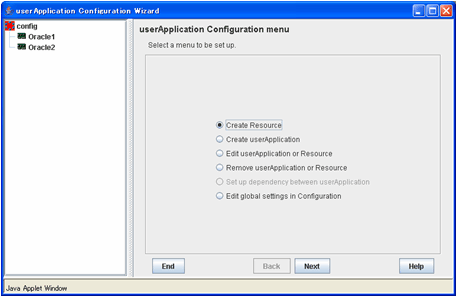
Select “Oracle” of “Resource type”.

For changing a resource name, select “ApplicationName”, and change the name. If you register the resource without changing the name, select “AdditionalRACInstance/Listener”.
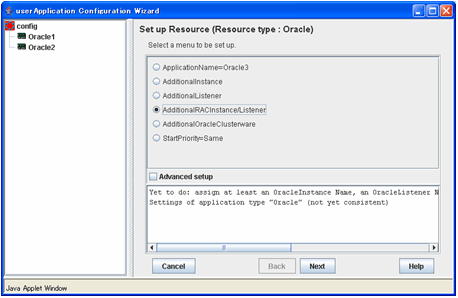
See
Based on the Oracle RAC resource name that is set in the AdditionalRACInstance/Listener, the Wizard for Oracle resource name is created on the RMS instance. For details, see “2.3.2 Oracle Software Installation and Configuration”.
Enter the Oracle DBA user name.

A list of available resources is displayed.
If it is not displayed, check “Advanced setup”, then specify a node with “ScopeFilter”.
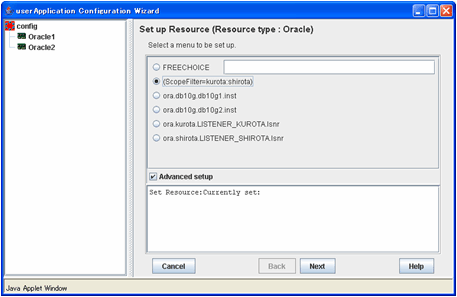
Input the name of a host where the resource belongs.
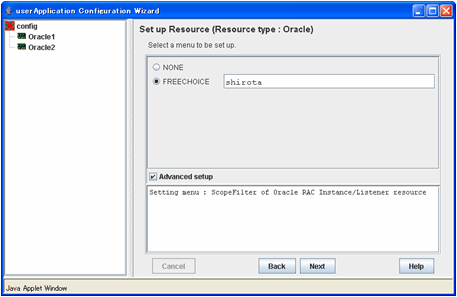
Select the resource (Oracle instance).
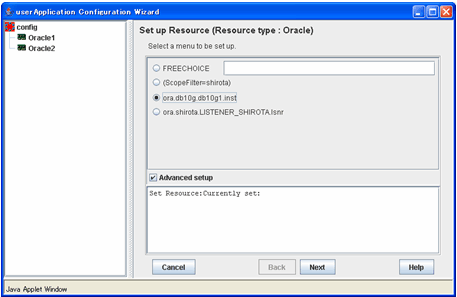
The resource will be displayed in the following message box, “Set Resource: Currently set:”. Select the resource (Oracle listener).
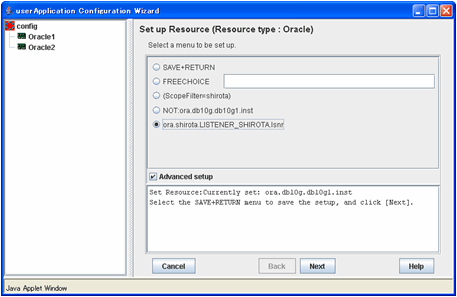
Note
Do not register the resources of the other nodes at the same time.
Check that the Oracle resource is set then save the settings by selecting “SAVE+RETURN”.
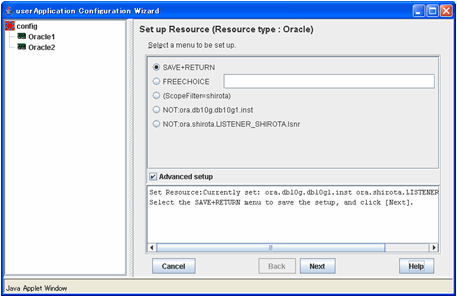
If you want to further set it, select each resource, then click the “Next” button.
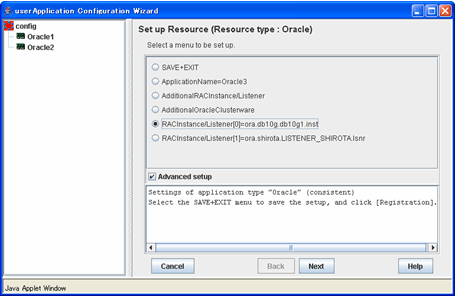
Select “SELECTED:<Resource>”, then click the “Next” button.
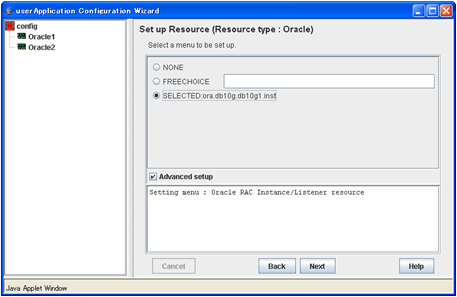
Select the menu, then click the “Next” button.
Selecting the “Advanced setup” allows you to set more details.
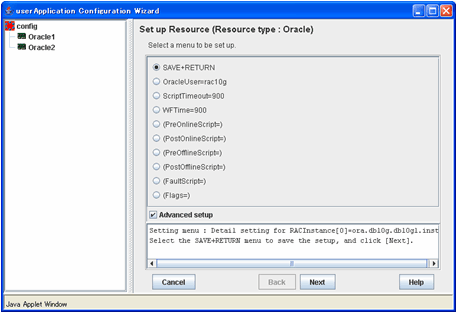
Attributes | Description | |
OracleUser | Oracle DBA user name | |
ScriptTimeout | Timeout of each resource startup and stop | |
WFTime | Waiting time for resource failure recovery through Oracle Clusterware | |
PreOnlineScript | Executed before online processing. | |
PostOnlineScript | Executed after online processing. | |
PreOfflineScript | Executed before offline processing. | |
PostOfflineScript | Executed after offline processing. | |
FaultScript | Executed when a fault occurs. | |
Flags | NullDetector | Selects whether or not a resource should be monitored. |
See
For details about Scripts, see “2.4.1 Oracle Online/Offline Script”.
For details about Flags, see “9 Appendix - Attributes” of the “PRIMECLUSTER RMS Configuration and Administration Guide”.
Note
Startup of Oracle Clusterware userApplication through PreOnlineScript
If Oracle Clusterware and Oracle RAC instance are registered in different userApplication (Configuration A), set up the following script in PreOnlineScript of the Oracle RAC instance resource;
/opt/FJSVclora/sbin/clorastartwait <userApplication with Oracle Clusterware>
Specify the following userApplication:
For app3 : app1
For app4 : app2
This setting enables that a userApplication including Oracle Clusterware resource starts up before starting up of userApplication including Oracle RAC instance resources.
WFTime
In Oracle RAC 10g or later, Oracle Clusterware will recover a failure of an RAC instance or listener instance. PRIMECLUSTER Wizard for Oracle, the wait time for the failure recovery can be set for WFTime.
If WFTime=PersistentWarning is set, completion of the failure recovery will be waited forever. In the meantime, an RMS resource will enter Warning, so userApplication will not be degenerated. As soon as recovery is detected, the RMS resource will get back to Online.
If WFTime=ImmediateFault is set, completion of the failure recovery will not be waited but an RMS resource will be considered as fault. As soon as the RMS resource fails, userApplication will be degenerated.
WFTime=<second> is set, completion of the failure recovery will be waited for a certain period of time. After the predetermined amount of wait time passes, an RMS resource will be considered as fault then userApplication will be degenerated. During the wait time, the RMS resource indicates Warning. If recovery is detected within the wait time, the RMS resource will get back to Online.
Flags
Flags=<Abbreviation> indicates that the flag attribute is enabled.
Save the settings by selecting “SAVE+RETURN”.
Check that the RACInstance/Listener is set then save the settings by selecting “SAVE+EXIT”.
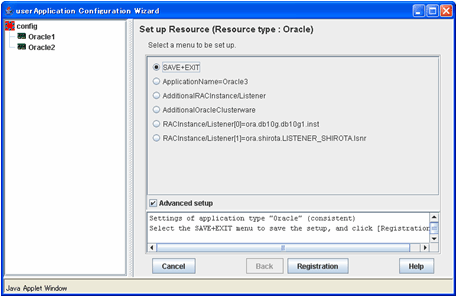
Repeat steps 1 through 10 for each node.